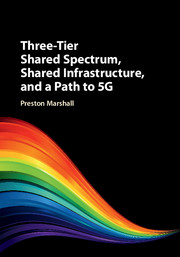Book contents
- Frontmatter
- Contents
- Acknowledgments
- Preface
- Part I Spectrum Sharing Background
- Part II Three-Tier Dynamic Spectrum Models
- Part III Components of a Three-Tier Architecture
- Part IV Protection Processes for Incumbents and Peers
- Part V Example Use of Three-Tier Spectrum: Use of the 3.5 GHz CBRS Band in the USA
- Part VI Future Bands, Network Services, Business Models, and Technology
- 15 Potential Services and Business Models Enabled by Three-Tier Spectrum
- 16 Candidate Incumbent Bands for Three-Tier Spectrum Sharing
- 17 From Shared Spectrum, to Shared Infrastructure, to a New Model of 5G
- 18 Future Actions to Deploy More Three-Tier Spectrum Bands and Nations
- 19 Alternatives to Three-Tier Operation
- 20 Conclusions and a Look Ahead
- Part VII Appendices
- Index
- References
20 - Conclusions and a Look Ahead
from Part VI - Future Bands, Network Services, Business Models, and Technology
Published online by Cambridge University Press: 30 August 2017
- Frontmatter
- Contents
- Acknowledgments
- Preface
- Part I Spectrum Sharing Background
- Part II Three-Tier Dynamic Spectrum Models
- Part III Components of a Three-Tier Architecture
- Part IV Protection Processes for Incumbents and Peers
- Part V Example Use of Three-Tier Spectrum: Use of the 3.5 GHz CBRS Band in the USA
- Part VI Future Bands, Network Services, Business Models, and Technology
- 15 Potential Services and Business Models Enabled by Three-Tier Spectrum
- 16 Candidate Incumbent Bands for Three-Tier Spectrum Sharing
- 17 From Shared Spectrum, to Shared Infrastructure, to a New Model of 5G
- 18 Future Actions to Deploy More Three-Tier Spectrum Bands and Nations
- 19 Alternatives to Three-Tier Operation
- 20 Conclusions and a Look Ahead
- Part VII Appendices
- Index
- References
Summary
Benefits and Roadmap of a Transition to Three-Tier
The future of three-tier spectrum is likely in the hands of the industry and operator communities that are engaged in its deployment. The regulators have created an opportunity for a new ecosystem; its success will be evaluated from the outcome of several deployment thrusts, such as the neutral-host model, enterprise, and Internet of Things (IoT), among others. It is not necessary that all succeed; one “killer app” is probably sufficient for an ecosystem to expand beyond the shores of the United States (US), and the 3.55 GHz band. It is not just that the US Citizens Broadband Radio Service (CBRS) is particularly important by itself; but, that a failure in the first deployment would certainly support and empower the opponents of any adoption anywhere, regardless of the reason for failure in the USA.
The rest of this section will address the scenario in which the US deployment is at least a partial success, and has sufficient economic and societal benefit that other nations have a desire to achieve at least these benefits, and maybe to tailor the regime to make it even more effective than the case in the USA.
On the other hand, if the US deployment is perceived to be a failure, then much of this material is irrelevant. The material in Section 20.5 may be of some use in resolving the perceived flaws in the three-tier regime.
Technology and Policy
Much of the discussion of this book has centered on spectrum-sharing technology; technology that is not specific to three-tier spectrum management regimes. The difference between general spectrum sharing and the specific three-tier model is that the three-tier model uses spectrum-sharing technology as a necessary enabler of a new, innovative, and potentially transformative regime, rather than an augmentation of current spectrum policies into a two-party sharing regime. Spectrum sharing is an admirable goal, but it is not equivalent to three-tier in terms of enabling ease of entry, of innovation, scalable deployment, and the maximum utilization of the spectrum.
- Type
- Chapter
- Information
- Publisher: Cambridge University PressPrint publication year: 2017



